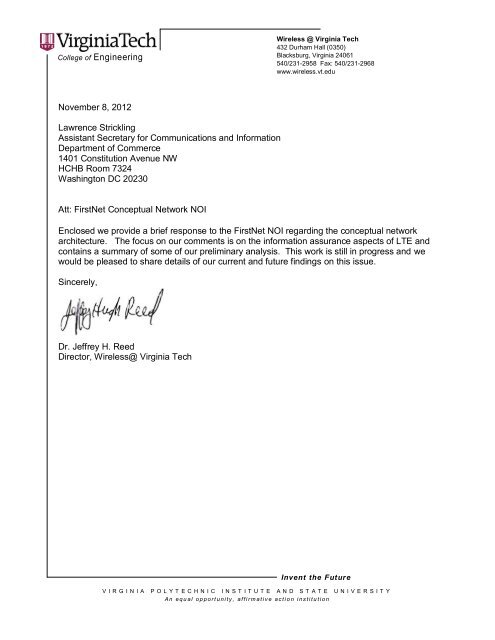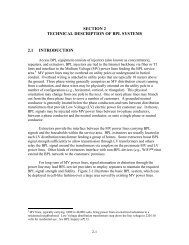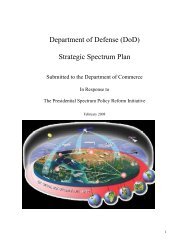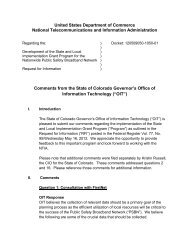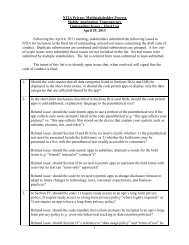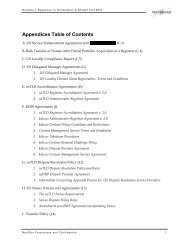Virginia Tech Letterhead - National Telecommunications and ...
Virginia Tech Letterhead - National Telecommunications and ...
Virginia Tech Letterhead - National Telecommunications and ...
You also want an ePaper? Increase the reach of your titles
YUMPU automatically turns print PDFs into web optimized ePapers that Google loves.
College of Engineering<br />
Wireless @ <strong>Virginia</strong> <strong>Tech</strong><br />
432 Durham Hall (0350)<br />
Blacksburg, <strong>Virginia</strong> 24061<br />
540/231-2958 Fax: 540/231-2968<br />
www.wireless.vt.edu<br />
November 8, 2012<br />
Lawrence Strickling<br />
Assistant Secretary for Communications <strong>and</strong> Information<br />
Department of Commerce<br />
1401 Constitution Avenue NW<br />
HCHB Room 7324<br />
Washington DC 20230<br />
Att: FirstNet Conceptual Network NOI<br />
Enclosed we provide a brief response to the FirstNet NOI regarding the conceptual network<br />
architecture. The focus on our comments is on the information assurance aspects of LTE <strong>and</strong><br />
contains a summary of some of our preliminary analysis. This work is still in progress <strong>and</strong> we<br />
would be pleased to share details of our current <strong>and</strong> future findings on this issue.<br />
Sincerely,<br />
Dr. Jeffrey H. Reed<br />
Director, Wireless@ <strong>Virginia</strong> <strong>Tech</strong><br />
Invent the Future<br />
V I R G I N I A P O L Y T E C H N I C I N S T I T U T E A N D S T A T E U N I V E R S I T Y<br />
A n e q u a l o p p o r t u n i t y , a f f i r m a t i v e a c t i o n i n s t i t u t i o n
BEFORE THE<br />
DEPARTMENT OF COMMERCE<br />
In the Matter of<br />
<strong>National</strong> <strong>Telecommunications</strong> <strong>and</strong><br />
Information Administration<br />
Development of the Nationwide<br />
Interoperable Public Safety Broadb<strong>and</strong><br />
Network<br />
)<br />
)<br />
)<br />
)<br />
)<br />
)<br />
)<br />
)<br />
Docket No. 120928505–2505–01<br />
RIN 0660–XC002<br />
COMMENTS OF WIRELESS @ VIRGINIA TECH<br />
Dr. Jeffrey H. Reed<br />
Willis G. Worcester Professor<br />
Director of Wireless @ <strong>Virginia</strong> <strong>Tech</strong><br />
432 Durham Hall, MC0350<br />
1145 Perry Street<br />
Blacksburg, VA 24061<br />
reedjh@vt.edu<br />
(540) 231 2972<br />
Marc Lichtman<br />
Graduate Research Assistant<br />
<strong>Virginia</strong> <strong>Tech</strong><br />
marcll@vt.edu<br />
INTRODUCTION AND EXECUTIVE SUMMARY<br />
The Wireless @ <strong>Virginia</strong> <strong>Tech</strong> research group appreciates the opportunity to respond to<br />
the <strong>National</strong> <strong>Telecommunications</strong> <strong>and</strong> Information Administration (NTIA) request for comments<br />
on the Development of the Nationwide Interoperable Public Safety Broadb<strong>and</strong> Network. This<br />
comment is regarding the vulnerability of LTE to intentional <strong>and</strong> sophisticated jamming attacks.<br />
If LTE technology is to be used for the air interface of the public safety network, then we<br />
should consider the types of jamming attacks that could occur five or ten years from now. It is<br />
very possible for radio jamming to accompany a terrorist attack, for the purpose of preventing<br />
communications <strong>and</strong> increasing destruction. Likewise it is possible for criminal organizations to
create mayhem among public safety personnel by jamming. In addition, it is possible for a<br />
jammer to increase its effectiveness by employing a sophisticated strategy. This is especially<br />
likely when every technical aspect of the target signal is known. An example strategy would be<br />
to target specific control or synchronization signals, in order to increase the geographic range of<br />
the jammer <strong>and</strong> better avoid detection. The availability of low-cost <strong>and</strong> easy to use softwaredefined<br />
radios makes this threat even more realistic.<br />
Preliminary research has been performed to show the extent to which LTE is vulnerable<br />
to jamming. It was shown that extremely effective attacks can be realized, using fairly low<br />
complexity. It would be in the interest of public safety to put forth an effort to find solutions to<br />
the described problem, <strong>and</strong> ultimately improve the wireless interface of Public Safety LTE.<br />
Preliminary Research<br />
In order to show the vulnerability of the LTE wireless interface to jamming, we present a<br />
series of efficient attacks that are designed to cause denial of service to one or more LTE cells.<br />
Each attack targets one or more LTE subsystems, either in the downlink or uplink signal. The<br />
selected attacks described below represent a balance between effectiveness <strong>and</strong> complexity.<br />
Synchronization Signal Jamming (SSJ): When a UE wants to connect to an eNodeB, it has to<br />
first go through a series of synchronization steps. First, it detects the Primary Synchronization<br />
Signal (PSS) which allows the UE to synchronize to each slot <strong>and</strong> gives it the cell ID. Next, it<br />
detects the Secondary Synchronization Signal (SSS) which tells the UE the cell ID group, which<br />
method of duplexing is used, <strong>and</strong> the cyclic prefix length. The SSS also allows the UE to detect<br />
when each radio frame starts. Both the PSS <strong>and</strong> SSS are mapped to the central 62 subcarriers
(not including the DC subcarrier). After synchronizing with the PSS <strong>and</strong> SSS, the UE receives<br />
more information about the cell by decoding the Master Information Block (MIB). The MIB<br />
contains information essential for initial access to a cell [1]. It consists of 14 bits that contain the<br />
downlink system b<strong>and</strong>width, the Physical Control Format Indicator Channel (PHICH) size, <strong>and</strong><br />
information allowing frame synchronization. It is mapped to the central 72 subcarriers, <strong>and</strong><br />
appears in slot 1 of each frame. The three signals are not present in all ten subframes, but they<br />
are always mapped to the same subcarriers.<br />
The Synchronization Signal Jamming (SSJ) attack is designed to deny the UE access to<br />
the PSS, SSS, <strong>and</strong> MIB. The jamming waveform used for the SSJ attack is noise that spans the<br />
center 73 subcarriers. The DC subcarrier is included for the sake of complexity, even though it<br />
does not contain information. The SSJ attack does not involve jamming specific symbols (it uses<br />
a 100% duty cycle), so the jammer does not have to be synchronized to the eNodeB. The SSJ<br />
attack is simply a brute force method of denying the UE three different mechanisms that it needs<br />
to access a cell. The act of only jamming certain subcarriers allows the SSJ attack to have<br />
roughly a 3 dB gain over traditional barrage jamming, which can be thought of as an increase in<br />
jamming radius for a jammer that is power constrained.<br />
Primary Synchronization Signal Jamming: Detecting the PSS is the first step a UE takes in<br />
accessing a cell. The PSS uses a sequence length of 63, <strong>and</strong> the center element is nulled because<br />
the downlink DC subcarrier is never used for transmission. There are three PSS sequences used<br />
in LTE, <strong>and</strong> each one corresponds to one of the three sectors. The UE must detect the PSS<br />
without any knowledge of the channel, so it finds the timing offset that corresponds to the
maximum cross-correlation for each of the three sequences, <strong>and</strong> uses it to synchronize in the time<br />
domain. For FDD, the PSS only occurs in slots 0 <strong>and</strong> 10 (there are 20 total slots per frame).<br />
The SSJ attack discussed previously injects noise into the subcarriers that contain the<br />
PSS. An attack that only targets the PSS can be realized by only jamming the symbols that<br />
contain the PSS. However, the jammer would have to cause a fairly high jammer-to-signal ratio,<br />
because the PSS is designed to be detected at high interference levels, so that the UE can also<br />
detect neighboring cells.<br />
A more effective method of causing a PSS attack would be to simply transmit one of the<br />
three PSS sequences, <strong>and</strong> thus create a bogus PSS. If the jammers received power at the UE is<br />
greater than the eNodeB's, then the UE is most likely going to synchronize to the bogus PSS.<br />
This is because a cross-correlation process is used to detect the PSS non-coherently. A jammer<br />
using this method would not need receiving capability, because it would simply start the bogus<br />
PSS transmission at a r<strong>and</strong>om time, leading to uniformly distributed timing relative to the correct<br />
PSS signal. If the UE synchronized to the bogus PSS, then is not synchronized in time to the<br />
eNodeB, <strong>and</strong> it will not know when each OFDM symbol starts, <strong>and</strong> hence will not be able to<br />
detect the SSS or decode the MIB.<br />
This attack appears to work, until considering the cell reselection procedure. If a cell<br />
does not provide a certain level of quality, then the UE begins the cell reselection procedure,<br />
where it tries to access the cell with the next strongest signal. The solution is to spoof all three<br />
PSS sequences. A jammer transmitting three bogus PSSs only has to transmit six symbols in<br />
every frame, on 62 subcarriers. A downside to PSS jamming is that it will not immediately<br />
cause Denial of Service (DOS). It will prevent new UEs from accessing the cell(s), <strong>and</strong> cause<br />
UEs in idle mode to reselect a bogus cell. Therefore PSS jamming is not effective for an attack
intended on causing immediate DOS. However, it is sufficient for an attack that will last a long<br />
period of time. Because the jammer barely has to transmit anything, the PSS jamming attack<br />
offers roughly 20 dB of gain relative to the barrage jamming attack. This results in an extremely<br />
efficient jammer.<br />
Fortunately, this type of attack can be prevented by employing a cell reselection<br />
implementation that is able to blacklist “bogus synchronization signals”, by keeping track of the<br />
time-delay in the cross-correlation. Although this is not required by the LTE specifications,<br />
adding this type of mitigation may be worthwhile in Public Safety UE.<br />
Physical Uplink Control Channel Jamming: The Physical Uplink Control Channel (PUCCH)<br />
is used to send the eNodeB a variety of control information, including scheduling requests,<br />
Hybrid Automatic Repeat Request (HARQ) acknowledgements, <strong>and</strong> channel quality indicators.<br />
The PUCCH is mapped to the resource blocks on the edges of the system b<strong>and</strong>width. These<br />
resource blocks are evenly split between the two edges of the system b<strong>and</strong>width, <strong>and</strong> the UE<br />
rapidly alternates between the two sets of resource blocks, for the purpose of frequency diversity.<br />
When a UE is transmitting on the PUCCH it is not transmitting anything else [2]. This allows<br />
PUCCH jamming to be feasible, even with SC-FDMA in use. PUCCH jamming is possible<br />
when the only a priori knowledge is the system b<strong>and</strong>width <strong>and</strong> location in the uplink signal in the<br />
frequency domain.<br />
The signal sent on the PUCCH by the UE depends on the type of information it wants to<br />
send. For scheduling requests, all the UE has to do is transmit energy in its assigned slot. This<br />
causes the eNodeB to assign the specific UE additional uplink resources. This means PUCCH<br />
jamming will cause the eNodeB to assign every active UE additional uplink resources (which
they probably do not need), <strong>and</strong> cause degradation of service. The signal transmitted by the UE<br />
for ACK <strong>and</strong> NACK responses is not as straightforward; it involves modulating the ACK or<br />
NACK indicator onto a predefined sequence which is then cyclically shifted <strong>and</strong> scrambled.<br />
This system is meant to allow multiple PUCCH transmissions to exist in the same time <strong>and</strong><br />
frequency slot. Successful PUCCH jamming will cause ACKs to not reach the eNodeB,<br />
resulting in retransmissions <strong>and</strong> further degradation of service. The last type of control<br />
information sent on the PUCCH is channel state information, which is used by the UEs to send<br />
the eNodeB information about the channel quality. The eNodeB uses this information to assign<br />
subcarriers to users that experience better channel conditions on the corresponding frequencies,<br />
as well as choose which modulation scheme to use. As in the ACK indicators, the information is<br />
sent to the eNodeB through modulation with a UE-specific sequence, which is then scrambled<br />
<strong>and</strong> cyclically shifted. The corruption of channel quality information is not as detrimental to the<br />
LTE service as missed ACKs, but it is likely to help accelerate the process of causing DOS.<br />
PUCCH jamming offers roughly 5 dB of gain compared to barrage jamming, because the<br />
jammer can focus its energy into the control channel subcarriers.<br />
Conclusion<br />
These comments describe extremely effective attacks can be realized, using fairly low<br />
complexity. It would be in the interest of public safety to take measures to reduce the<br />
vulnerability of Public Safety LTE, <strong>and</strong> lower the likelihood of an effective jamming attack.<br />
Certainly there are important cost advantage of keeping the public safety LTE system compatible<br />
with commercial devices <strong>and</strong> systems. Seeking solutions that achieve this compatibility while
providing protection are desirable. We thank you for considering our views, <strong>and</strong> are eager to<br />
address any subsequent questions.<br />
References<br />
[1] Matthew Baker <strong>and</strong> Tim Moulsley. Downlink physical data <strong>and</strong> control channels. In Stefania<br />
Sesia, Issam Toufik, <strong>and</strong> Matthew Baker, editors, LTE, The UMTS Long Term Evolution: From<br />
Theory to Practice, chapter 9. John Wiley & Sons Ltd, Chichester, West Sussex, United<br />
Kingdom, second edition, 2011.<br />
[2] 3GPP <strong>Tech</strong>nical Report 36.211, “Physical Channels <strong>and</strong> Modulation”, www.3gpp.org.<br />
Dr. Jeffrey H. Reed<br />
Willis G. Worcester Professor<br />
Director of Wireless @ <strong>Virginia</strong> <strong>Tech</strong><br />
<strong>Virginia</strong> <strong>Tech</strong><br />
Marc Lichtman<br />
Graduate Research Assistant<br />
<strong>Virginia</strong> <strong>Tech</strong>


